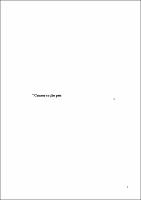Please use this identifier to cite or link to this item:
https://rima.ufrrj.br/jspui/handle/20.500.14407/13700| Tipo do documento: | Dissertação |
| Title: | Conservação pós-colheita de folhas de Pereskia aculeata (ora-pro-nóbis) em diferentes tipos de embalagens |
| Other Titles: | Post-harvest conservation of pereskia aculeata leaves (ora-pro-nóbis) in different types of packages |
| Authors: | Pereira, Bruna da Silva Gomes |
| Orientador(a): | Coneglian, Regina Celi Cavestré |
| Primeiro coorientador: | Fonseca, Marcos José de Oliveira |
| Primeiro membro da banca: | Brotel, Neide |
| Segundo membro da banca: | Martelleto, Mariluci Sudo |
| Keywords: | Hortaliças não-convencionais;armazenamento;atributos de qualidade;Non-conventional Vegetables;storage;quality atributes |
| Área(s) do CNPq: | Agronomia |
| Idioma: | por |
| Issue Date: | 23-Feb-2017 |
| Publisher: | Universidade Federal Rural do Rio de Janeiro |
| Sigla da instituição: | UFRRJ |
| Departamento: | Instituto de Agronomia |
| Programa: | Programa de Pós-Graduação em Fitotecnia |
| Citation: | Pereira, Bruna da Silva Gomes. Conservação pós-colheita de folhas de Pereskia aculeata (ora-pro-nóbis) em diferentes tipos de embalagens. 2017. [55 f.]. Dissertação( Programa de Pós-Graduação em Fitotecnia) - Universidade Federal Rural do Rio de Janeiro, [Seropédica - RJ] . |
| Abstract: | As hortaliças não-convencionais são plantas alimentícias que apresentam elevado valor nutricional, embora ainda pouco estudadas e desconhecidas por grande parte da população. O incentivo ao consumo de hortaliças não-convencionais resulta em dietas mais saudáveis, prevenção de doenças e melhor qualidade de vida, atendendo inclusive as classes mais carentes da sociedade devido ao seu baixo custo de aquisição. Considerando a deficiência do mercado brasileiro em manter a qualidade dos produtos hortícolas atribuído aos altos índices de perdas pós-colheita, principalmente as hortaliças folhosas, busca-se encontrar melhores alternativas de armazenamento e conservação de alimentos na pós-colheita. Neste contexto, o objetivo deste trabalho foi avaliar o tempo de vida útil e qualidade pós-colheita da hortaliça não-convencional, Pereskia aculeata, conhecida como ora-pro-nóbis, acondicionando-se as folhas em sacos de polipropileno (PP), bandejas de poliestireno expandido revestidas com filme plástico (EPS + Filme) e bandejas de politereftalato de etileno (PET) à temperatura de 5°C e UR de 90% durante 9 dias de armazenamento. Foram realizadas análises físicas e químicas, onde as embalagens do tipo bandejas EPS + filme apresentaram menor perda de massa das folhas e as bandejas PET mantiveram os teores de clorofilas totais das folhas. Para os atributos de cor L*, C* e °H as folhas acondicionadas nos três tipos de embalagem não apresentaram diferença significativa ao longo do tempo de armazenamento, além das análises de clorofila a e b, perfil de carotenóides, pH, ATT, SST, compostos fenólicos e atividade antioxidante. Conclui-se que nas três embalagens testadas houve manutenção dos atributos de qualidade das folhas de ora-pro-nóbis até o 9° dia de armazenamento onde as folhas se mostraram fonte de pigmentos carotenóides. |
| Abstract: | The non-conventional vegetables are food plants which have high nutritional value, although little studied and still unknown to much of the population. The encouragement of the consumption of non-conventional vegetables results in healthier diets, disease prevention and better quality of life, given even the poorest classes of society due to their low cost. Whereas deficiency of the Brazilian market to maintain the quality of the vegetables attributed to high rates of post-harvest losses, especially leafy vegetables, there is a search for better alternatives for storage and conservation of post-harvest food. In this context, the objective of this work was to evaluate the life and postharvest quality of non-conventional vegetable, Pereskia Aculeata, known as ora-pro-nóbis, conditioning the leaves in bags of polypropylene (PP), polystyrene trays expanded lined with plastic wrap (EPS + movie) and polyethylene terephthalate trays (PET) at a temperature of 5° C and RH of 90% for 9 days of storage. Physical and chemical analyses had been conducted, where the PP were more efficient at maintaining the color, for the parameter b *. The EPS trays + movie showed reduced leaf mass loss and the PET trays kept efficiently the total chlorophylls of leaves. For the attributes of color L *, a * and H the leaves packed in three packaging types showed no significant difference over the storage time, in addition to the analysis of chlorophyll a and b, carotenoids, pH profile, ATT, SST, phenolic compounds and antioxidant activity. It was concluded that in the three packages tested the quality atributes of the leaves of the ora-pro-nóbiswere maintained until the 9th day of storage where the leaves were shown to be the source of carotenoid pigments. |
| URI: | https://rima.ufrrj.br/jspui/handle/20.500.14407/13700 |
| Appears in Collections: | Mestrado em Fitotecnia |
Se for cadastrado no RIMA, poderá receber informações por email.
Se ainda não tem uma conta, cadastre-se aqui!
Files in This Item:
| File | Description | Size | Format | |
|---|---|---|---|---|
| 2017 - Bruna da Silva Gomes Pereira.pdf | 2017 - Bruna da Silva Gomes Pereira | 4.57 MB | Adobe PDF |  View/Open |
Items in DSpace are protected by copyright, with all rights reserved, unless otherwise indicated.

